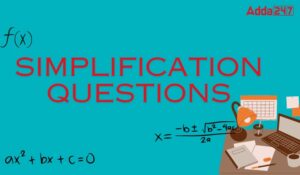Dear Students,
Quantitative Aptitude Questions for IBPS Exam
Quantitative Aptitude is a very important section you must prepare if you are aiming for a job in Bank or Insurance sector. These two weeks are very important as IBPS PO and Clerk Mains are lined up. So, these 15 questions can help you practice three very important topics of Quant Section.
Q1. If the ratio of boys to girls in a class is B and the ratio of girls to boys is G, then 3 (B + G) is:
(a) Equal to 3
(b) Less than 3
(c) More than 3
(d) Less than one-third
(e) None of these
Q2. A driver’s income consists of his salary and tips. During one week, his tips were five-fourths of his salary. What fraction of his income came from tips?
(a) Four-ninths
(b) Five-ninths
(c) Five-eights
(d) Five-Fourths
(e) None of these
Q3. A sum of Rs 18750 is left by a father will be divided between two sons of 12 and 14 years of age, so that when they attain maturity at 18, the sum (principal + interest) received by each at 5 percent simple interest will be the same. Find the sum allotted at present to each son.
(a) Rs 9000, Rs 9750
(b) Rs 8000, Rs 1750
(c) Rs 9500, Rs 9250
(d)Rs. 10000, Rs. 8750
(e) None of these
Q4. A bottle is full of dettol. One-third of it is taken out and then an equal amount of water is poured into the bottle to fill it. This operation is done four times. Find the final ratio of dettol and water in the bottle.
(a) 13 : 55
(b) 20 : 74
(c) 16 : 65
(d) 10 : 48
(e) None of these
Q5. Vijay purchased two different kinds of alcohol. In the first mixture, the ratio of alcohol to water is 3 : 4 and the second mixture it is 5 : 6. If he mixes, the two given mixtures and makes a third mixture of 18 litres in which the ratio of alcohol to water is 4 : 5, the quantity of the first mixture (whose ratio is 3 : 4) that is required to make 18 litres of the third kind of mixture is:
(a) 6
(b) 7
(c) 8
(d) 9
(e) None of these
Directions (6-10): In each of the following questions a number series is given. After the series a number is given followed by (a), (b), (c), (d) and (e). You have to complete the series starting with the given number, following the sequence of original series and answer the questions that follow the series.
Q6. 3 19 103 439 1381 2887
5 (a) (b) (c) (d) (e)
What will come in place of (b) ?
(a) 139
(b) 163
(c) 161
(d) 157
(e) None of these
Q7. 4 13 40 135 552 2765
2 (a) (b) (c) (d) (e)
What will come in place of (c) ?
(a) 123
(b) 133
(c) 127
(d) 131
(e) None of these
Q8. 5 12 4 10 3 8
6 (a) (b) (c) (d) (e)
What will come in place of (d) ?
(a) 3
(b) 5
(c) 4
(d) 7
(e) None of these
Q9. 3 13 37 87 191 401
1 (a) (b) (c) (d) (e)
What will come in place of (d) ?
(a) 169
(b) 161
(c) 171
(d) 159
(e) None of these
Q10. 8 4 6 15 52.5 236.25
12 (a) (b) (c) (d) (e)
What will come in place of (c) ?
(a) 23.5
(b) 16.5
(c) 22.5
(d) 22.25
(e) None of these
Directions (11-15): In the following questions two equations numbered I and II are given. You have to solve both the equations and–
Give answer (a) if p>q
Give answer (b) if p≥q
Give answer (c) if p<q
Give answer (d) if p≤q
You may also like to Read:
- Quantitative Questions for upcoming Banking and Insurance Examinations
- Study Notes of Quantitative Aptitude
- Practice More Data Interpretation Questions
- Quantitative Aptitude Section Strategy





 Simplification Questions For Bank Exams ...
Simplification Questions For Bank Exams ...
 Quantity Comparison Questions for Bank E...
Quantity Comparison Questions for Bank E...
 Mixture & Alligation Questions for B...
Mixture & Alligation Questions for B...




